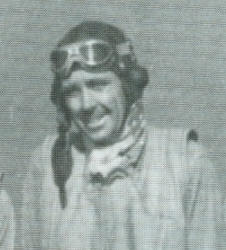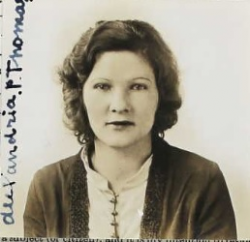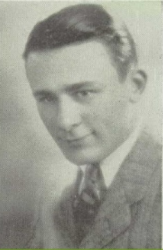
 |
|
|
||
|
HAROLD "R." THOMAS |
||||
|
Engagements: • World War II (1941 - 1945) |
||||
| Biography: | ||||
|
Harold was the son of Grace Myrtle Thomas the daughter of Edmund C. and Anna Hertel Wortman Thomas. Apparently, Harold was born out of wedlock to Grace and an unknown father. Several years after Harold's birth on 03 Apr 1906, his mother married William Franklin Zobel on 16 Feb 1908 in Shelby Twp, Shelby, IN. They were the parents of six children; Garnet Edmund, Lowell Emerson, Armelda Josephine, Kenneth Karl, Beverly Blaine and Oscar Lowell Zobel. The children were half-siblings to Harold. It is not known whether or not any of the Zobel children knew of the existence of their half-brother. Harold probably lived with his mother and maternal grandparents, Edmund C. and Anna Thomas, for only the first 3-4 years of his life. Harold was enumerated in the 1910 US census living with Edmund and Anna Thomas. On 01 Jan 1920, Harold lived with his great aunt, Edmund's sister, the widow Mary Thomas Barrett, 60, in Marion, IN. According to the 1940 San Diego, CA US Census, Harold completed the eighth grade in school. Harold R. Thomas enlisted in the US Navy (NSN: 291-11-1191) about 1924. He went to recruit training at the Naval Training Station, Great Lakes. Few details of his early navy career are available but it is known that he was serving in China, probably with the Asiatic Squadron's Yangtze River Patrol. During this time he met and married Alexandria Petrovina Mujetskaya on 16 Dec 1932 in Tientsin, China. She was born of Russian parents on 10 Jun 1910 in Harbin, China. They had one child, Donna Sue Thomas, born 19 Nov 1936 in Washington, DC. Thomas was probably transferred back to the US in 1933. His wife, Alexandria, a passenger on board the transport ship USS Chaumont (AP-5) underway from Manila, P.I. on 12 Sep 1933 and arriving at San Francisco, CA on 04 Oct 1933. Not long after returning to the United States, Thomas transferred to Washington, DC about 1934. After his tour of duty ended in Washington, Petty Officer Thomas was assigned to Scouting Squadron Six (VS-6) embarked on the aircraft carrier, USS Enterprise (CV-6) in 1940. The gunners were under the direction of a senior petty officer in each of the Enterprise bomber squadrons. For VS-6 that responsibility was under the direction of RM1 Harold Thomas. Many of his teenage radioman were quite young, so Thomas at age thirty-five was truly a father figure to many of them. Thomas had an engaging smile and the weathered faced radioman took his charge's mistakes with patience and encouragement. He would explain the seriousness of the situation and help the newer men work to prevent making the same mistake again.As fate would have it, Thomas' youngest half-brother, Oscar Zobel, was transferred to the Enterprise and Scouting Squadron Six on 13 Aug 1941 after he completed Aviation Machinist's Mate school at NAS San Diego. Prior to his assignment to Enterprise, S1c Zobel had been assigned to the battleship USS Oklahoma (BB-37). He had enlisted in the Navy on 13 Aug 1940 in Cleveland, OH. During 1941 Enterprise made 13 round trips between Hawaii and San Diego from April - Nov conducting exercise cycles and squadron work-ups. During those months she also shuttled Army Air Force P-39s and P-40s, as well as, Navy aircraft from US West Coast ports to Pearl Harbor and beyond. On 28 Nov 1941, Enterprise, now operating in a war-time steaming condition, left San Diego with a cargo of Marine Fighting Squadron 211 (VMF-211) aircraft and pilots destined for Wake Island. The Marine pilots and their planes flew from Enterprise to Wake Island on 02 Dec 1941. Enterprise was scheduled to arrive back in Pearl Harbor on 06 Dec, but was delayed due to inclement weather. As the most senior radioman of VS-6, Thomas would always fly with the skipper, Lcdr Hopping. And so it was in the early pre-dawn hours of 07 Dec 1941, Enterprise was 200 miles west of Oahu heading for a late afternoon docking at Pearl Harbor. Admiral Halsey planned to send 18 SBD planes to search 150 miles ahead of the task force as a normal precaution. Instead of returning to Enterprise, the search flight was to continue directly to Pearl Harbor. The rest of the air group would follow that afternoon before she entered port. Leading the mission was Lcdr Howard L. Young, Commander Enterprise Air Group in his own SBD, thirteen scout bombers from Lcdr Halstead L. Hopping’s Scouting Six (6-S-1) and four from Lcdr William R. Hollingsworth’s Bombing Six. Launching began at 0618. Operating under strict radio silence, Halsey had not alerted Pearl Harbor that his dive bombers were coming. He assumed his aircraft would not have any trouble identifying themselves, and ordinarily they wouldn’t. However, at 0753, 183 Japanese fighters, bombers and torpedo planes swarmed over the unsuspecting US Pacific Fleet. When the dive bombing group arrived over Pearl Harbor they were attacked by Japanese aircraft and shot at by friendly AA fire. Lcdr Hopping was enroute to Barbers Point Naval Air Station when he saw heavy smoke in the distance. When abreast of Ewa Field he sighted the first Japanese planes, and they were attacking the field. Hopping broadcast a warning over his radio that Pearl Harbor was being attacked by Japanese aircraft. He landed at Ford Island at 0845 during the second attack encountering heavy friendly anti-aircraft fire. He was directed by Commander, Patrol Wing Two to send one plane to investigate reports of two Japanese carriers southwest or west of Barbers Point between 25 and 40 miles. He was to hold remaining planes on the ground as an attack group. His aircraft took off again at 1030 for the directed search mission. At 1145, he landed at Ford Island and made his scouting report to ComPatWing Two that there were no Japanese surface craft within his search area. He was then directed to make another search and to attack enemy forces encountered and return to Ford Island. At 1210 Lcdr Hopping led nine VSB (six Scouting Six planes, Group Commanders plane and two Bombing Six planes) armed with 500 lb bombs on this search mission. They found no enemy shipping and returned to Ford Island by 1545. Lcdr Hopping’s group then received orders from Lcdr Young to return to Enterprise which they did the next morning (CEAG Lcdr Young after-action report). Among the group that departed Enterprise early in the morning for the run-in to Barbers Point, seven SBDs were shot down, either from enemy action or friendly fire, eight airmen were killed (three pilots and five gunners) and two wounded. After the debacle at Pearl Harbor, Enterprise was sent on a belated attempt to relieve Wake Island. Wake Island was overrun and surrendered on 23 Dec 1941 before Enterprise could come within range. On 09 January 1942, Admiral Nimitz directed Admiral Halsey to raid the southern Marshall and northern Gilbert area employing air attack and ship bombardment. On 01 Feb 1942, Enterprise with TF 8 were to attack Kwajalein, Wotje, and Maloelap in the Marshall Islands marking the first offensive action by US forces in the Pacific. Flight quarters sounded at 0345 and not long after 0400 the word, “Pilots, man your planes!” was passed. Launching began at 0445 with the fighters for the combat air patrol (CAP) launching first. They were followed by thirty-seven dive-bombers; eighteen each from Bombing Six and Scouting Six, plus Lcdr Brigham Young in the CEAG plane. The last to launch were the nine bomb-armed Devastators of Torpedo Six. During the attacks the primary objectives for the scouting squadron, led by Lcdr Hal Hopping (6-S-1) with his gunner, RM1 Harold “R” Thomas, was to make a gliding attack to strafe and drop 100-pound bombs on the air field, planes on the ground, hangers, fuel tanks, and other installations on Roi-Namur. The scouting squadron was composed of a three-division formation, six planes per division. The attack package arrived over Roi shortly before dawn at fifteen thousand feet. Alerted by the noise from many approaching engines, the Japanese began manning anti-aircraft batteries and fighter aircraft to intercept the incoming American planes. Lcdr Hopping led Scouting Six. The squadron was first to push over at fourteen thousand feet at 0705. Below, enemy anti-aircraft guns began firing putting black bursts of AA fire into the sky, and Japanese Type 96 fighters (Mitsubishi A5M “Claudes”) launched from the Roi airfield. Each SBD took station behind and to the right of Hopping’s leading bomber. Gliding over the beach, Hopping released his bombs over the airfield becoming the first American ordnance to explode on Japanese territory in WWII. By this time almost a score of Type 96 Japanese fighters were airborne to challenge the SBDs. As Hopping pulled out of his dive low and level over the island an enemy fighter bore in on Hopping’s six o’clock. As witnessed by several of his junior pilots, Hopping’s Dauntless was hit by both shore gunners and the Claude on his tail. Hopping and Thomas returned fire, but only for a few moments. Heavily damaged, their SBD spun into Pacific northeast of Roi. Both Lcdr Hopping and the squadron’s senior radioman, RM1 Harold “R” Thomas, died in the ensuing crash. Their remains were unrecoverable. They were reported missing in action on 01 Feb 1942 (Because their remains were not recovered they were considered MIA). They were presumed dead on 2 Feb 1943. RM1 Thomas' wife was notified of about 17 Feb 1942. She notified, Thomas' mother, Mrs Grace Zobel, on 18 Feb 1942 that he was missing in the service of his country. Radioman First Class (RM1) Harold R. Thomas was awarded (Posthumously) the Purple Heart, Presidential Unit Citation w/ribbon, American Defense Medal, Asiatic-Pacific Campaign Medal with one bronze battle star and the WWII Victory Medal. ------------------------------------- The Presidential Unit Citation reads: For consistently outstanding performance and distinguished achievement during repeated action against enemy Japanese forces in the Pacific war area, 7 December 1941, to 15 November 1942. Participating in nearly every major carrier engagement in the first year of the war, the Enterprise and her air group, exclusive of far-flung destruction of hostile shore installations throughout the battle area, did sink or damage on her own a total of 35 Japanese vessels and shot down a total of 185 Japanese aircraft. Her aggressive spirit and superb combat efficiency are fitting tribute to the officers and men who so gallantly established her as an ahead bulwark in the defense of the American nation. Actions of the Enterprise mentioned in the citation include the Gilbert and Marshalls of 01 Feb 1942; Wake Island raid, 24 Feb 1942; Marcus Island raid, 04 Mar 1942; Battle of Midway, 4-6 Jun 1942; Occupation of Guadalcanal, 7-8 Aug 1942; Battle of Stewart Islands, 24 Aug 1942; Battle of Santa Cruz Islands, 26 Oct 1942; and Battle of Solomon Islands, 14-15 Nov 1942. ----------------------------- His family also received a commemoration from President Franklin D. Roosevelt. It reads: In grateful memory of Harold R Thomas, who died in the service of his country at SEA, Pacific Area, ATTACHED U.S.S. ENTERPRISE, 2 February 1943 (Presumed). He stands in the unbroken line of patriots who have dared to die that freedom might live and grow and increase its blessings. Freedom lives, and through it, he lives -- in a way that humbles the undertakings of most men. (Signed) Franklin D. Roosevelt, President of the United States --------------------- Combat Action Ribbon (CR) note: None of the Navy/Marine flight crews in the Battle of Midway were eligible for or were awarded the Combat Action Ribbon (CR). See Navy and Marine Corps Awards Manual (SECNAVINST M-1650.1 of 16 Aug 2019, Appendix 2C.1.c (3) Amplifying Guidance). It reads in part, “The CR will not be awarded in connection with aerial flight, . . . “ The CR was established in 1969 and made retroactive to 07 Dec 1941. According to the Awards Manual, when deemed appropriate, the award for aerial combat is the Air Medal. [Bio #209 compiled by Gerry Lawton (GML470/G47) Military Hall of Honor ID: 103167 Find A Grave Memorial Page: 238489618 |
||||
| Honoree ID: 103167 | Created by: MHOH | |||
Ribbons
Medals
Badges
Honoree Photos
 |  |  |
 |  |
 |


